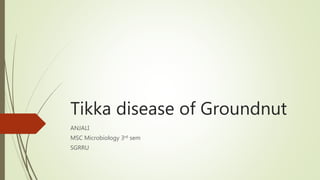Tikka disease
- 1. Tikka disease of Groundnut ANJALI MSC Microbiology 3rd sem SGRRU
- 2. Content ïī Introduction ïī Causal Organism ïī Symptoms ïī Disease Cycle ïī Favourable Condition ïī Disease Management ïī Conclusion ïī Reference
- 3. Introduction ïī Groundnut is the most important oilseed crop of india ïī The total area under ground nut is about 8 million hectares ïī Tikka disease is the major disease of groundnut In india ïī It occurs in every state in India and in every ground of nutgrowing countries of the world ïī In Uttar Pradesh , the disease locally known as chitwa or haldai
- 4. Causal organism ïī The causal organism of this disease are Cercospora personata and Cercospora arachidicola ïī The symptom caused by the two pathogen will differ ïī This disease also called Leaf spot of Ground nut because it causes Leaf spot on the leaves
- 5. Symptoms ïī Symptoms appear when the plants are 1 or 2 months old ïī Due to excessively spotting on the leaves , there is gradual weakening of the foliage which results in defoliation ïī Consequently , fewer and smaller nurs are formed ïī According to sundarram (1965) severe intensity of infection leads upto 22% reduction in yield
- 6. Symptoms ïī C.arachidicola causes early spot and C.personata causes late spot ïī First symptom of both leaf spots is the appearance of pale areas on the upper surface of older leaves ïī As the lesion develops the two species can ve distinguished
- 7. Early leaf spot symptoms ïī Sub circular dark brown spots are produced on the upper leaflet surface ïī Spots are of lighter shade of brown on the lower side of leaflets ïī Yellow halo is seen around the brown spots
- 8. Late leaf spot symptoms ïī Late leaf spots are nearly circular and darker than early leaf spots ïī Yellow halo develops around each only in later stage of development ïī Late leaf spots can be distinguished from those of early leaf spots ïī Late Leaf spots are darker with no or light yellow halo
- 9. Causal organism ïī The mycelium of C.arachidicola is inter and intracellular,brown, septate and without haustoria. ïī Conidiophores are yellow brown and as the conidium remains attached to geniculation oj conidiophore. ïī Conidiophore are 22-44 micron long and 3-5 microm broaf continuous or 1-2 septate.
- 10. Causal organism ïī Cercospora personata produces an intercellular branched mycelium ïī To absorb food from the host tissue, haustoria are developed. ïī Lesions appear 2-4 weeks later. ïī Conidiophore of C.personata are 25-54 micron long,5-8 mircon Broad continuous or 1-2 septate. ïī Conidia are terminal and each conidiophore bear each single conidium at the apex. ïī It is potentially more damaging because it produces more spots, spreads faster and causes earlier defoliation.
- 11. Dieseade cycle ïī Perennation ïī The disease perpertuates through conidia lying in the soul on diseased plant debris and through conidia being carried in thr shell of groundnut. ïī Primary Infection ïī When the new crop of Groundnut starts growing,the viable conidia are brought to the host surface by various agencies, germinate in favourable conditions and cause primary Infection. ïī Secondary infection ïī The secondary infection on healthy plants in the same field or adjacent fields is brought by conidia produced on primary infected leaves.
- 12. Cont..... ïī The conidia are dispersed by air or other agencies , which bring them on the healthy leaves ïī Later , they germinate in favourable conditions and causes infection
- 13. Favourable factors ïī Relative humidity is the most important factor for infection ïī A period of three days of high humidity is essential for maximum infection ïī Prolonged low temperature and dew also favour Severe infection
- 14. Unfavorable condition ïī Application of potash slightly decrease disease incidence ïī Leaf spot development is minimal when gypsum is applied as a source of calcium
- 15. Disease management ïī As the disease is soil borne, proper crop rotation is needed ïī Plant disease debris should be burnt to avoid soil infection ïī Early planting, alteration in date of sowing and use of maturing varieties helps to escape room the attack of disease ïī Foliage spray with Bordeaux mixture , Dithane M-45(.2%), Benlate and Bavistin (0.1) give good result
- 16. Conclusion ïī Tikka disease is the common disease in ground nut caused by Cercospora arachidicola and Cercospora personata ïī In the diseased condition , many circular spots appear on the surface of leaf ïī Conidia of the fungus present in soil or those present in the fruit shell is the source of infection ïī Use of fungicides controls the disease















